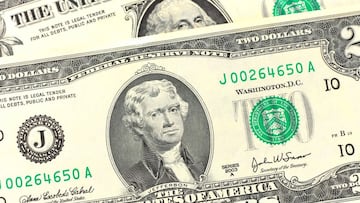These $2 bills could be worth $20,000: How do I know if I have one?
It could pay off to look closely at the cash in your wallet. There are $2 bills that can be worth up to $20,000. Here’s how to find out if you have one.

Although the vast majority of coins and bills in circulation are only worth their face value, some specimens can sell for thousands of dollars to collectors.
This is the case for certain $2 bills, which, thanks to certain characteristics, could be worth up to $20,000. Find out how to know if you have one.
These $2 bills could be worth $20,000: How do I know if I have one?
According to MarketWatch, some uncirculated $2 bills can be worth a small fortune. Their value in thousands of dollars depends on a few factors: the serial numbers, when the bills were printed, and their condition.
Serial number
The serial number, which is printed on the left and right sides of the front of the bill, usually with a letter on the front, is one of the main factors that can raise the price of a bill.
“A serial number ‘1′ for a 1976 $2 bill would be worth $20,000 or more,” Dustin Johnston, vice president of Heritage Auctions, told Marketwatch.
Other high-value serial numbers include so-called “ladders” or “solids.” Solid serial numbers are codes that have the same digit, such as 88888888888. meanwhile, a ladder number features digits listed in ascending order, such as 12345678910.
READ ALSO: What experts say it will cost to fill up during the holiday season
Antiquity
Johnston also told the financial portal that much of the value of a bill lies in its age. For example, those that were printed before the 1920s and are more than 100 years old are often worth much more than their face value.
However, it's not just about the year of printing, as the number of banknotes printed in a given year, as well as the number of banknotes in circulation, can also affect their rarity.
Condition
Another important factor to consider is the condition of the bill. Trying to sell a crumpled bill to a collector is not the same as trying to sell one that is well cared for or even classified as a collector's item and encapsulated for conservation.
READ ALSO: California tops the table of most unaffordable homes in the country
Other aspects that are taken into account to determine the value of a bill or coin
According to the US First Exchange site, there are four types of value:
- Catalog value
- Purchase price
- Public or retail sales value
- Wholesale value
The catalog value is the average price that most would sell a coin or note for. The purchase price is what a merchant would be willing to pay. Retail value is the price for which a specific dealer would be willing to sell you a coin or note. The wholesale value is the price that merchants use when they trade with each other.
According to the portal, the value of a coin or note is essentially determining the value of the catalog based on three main factors: rarity, condition/grade of the coin or note and market conditions, i.e. demand. The combination of these three factors determines whether a coin or bill is worth more or less money.





